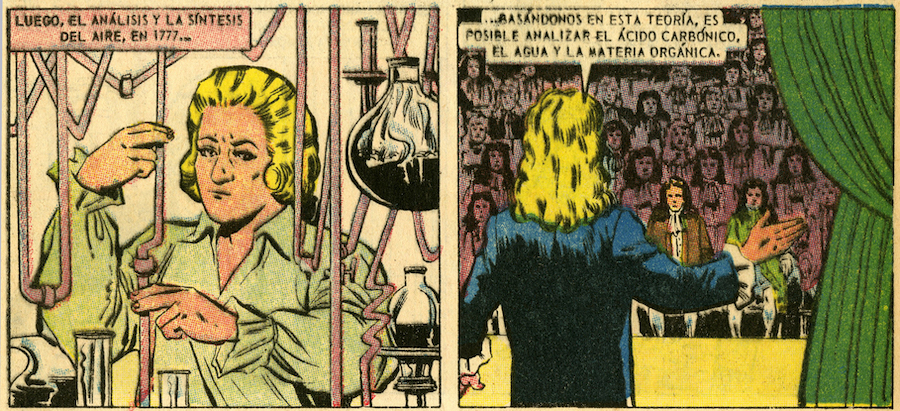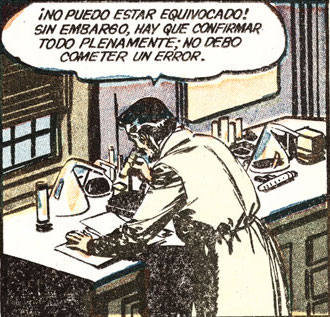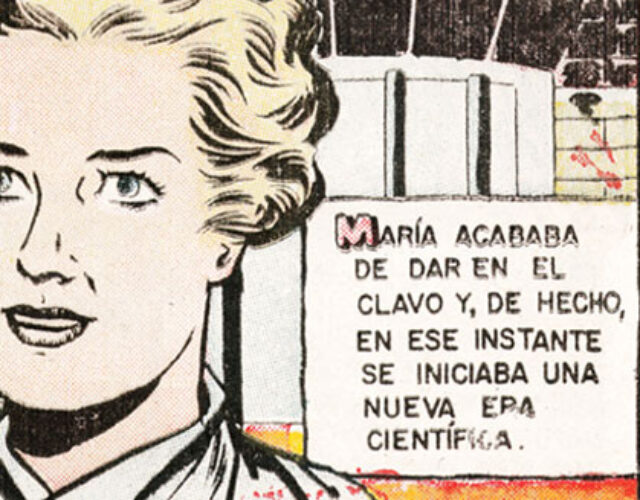About 50 years ago in the small town of Ataco, Colombia, 10-year-old Manuel Patarroyo discovered Louis Pasteur—in a comic book. His father gave him the small booklet describing the life and work of Pasteur that included the story of the scientist’s creation of a vaccine against rabies, a terrifying disease. That comic shaped Patarroyo’s future. While other children dreamed of becoming policemen, firefighters, or pilots, he yearned to become a scientist. “I did not want to do anything different than what Pasteur did,” he recalled decades later in an interview. Even after gaining worldwide attention for developing a malaria vaccine in 1987, Patarroyo still remembered the influence of the colorful little story of a chemist in a comic book.
Puerto Rico–raised José G. Rigau-Pérez, a physician, epidemiologist, and retired captain in the U.S. Public Health Service, remembers reading some of the same Spanish-language comics as Patarroyo, including the one on Pasteur. He also has vivid memories of a comic about Nikola Tesla, its cover dominated by a huge spark between towering electrodes, and another about Evangelista Torricelli—“the most unforgettable cover”—with Torricelli holding a barometer as a lady in baroque dress leans over to kiss him.

A Vidas Ilustres comic about Lavoisier depicts the scientist identifying constituents of air through experiments on combustion. At right, Lavoisier shares his discovery with an audience.
The vivid accounts of Patarroyo and Rigau-Pérez are a testament to the special hold such comic books had on young children in Latin America. The Vidas Ilustres series first appeared in the 1950s, published in Mexico City and distributed across Latin America and Spain. Individual comics featured chemists alongside a wide array of well-known historical figures, such as Rembrandt, Charlie Chaplin, Winston Churchill, Napoleon Bonaparte, and Sigmund Freud. Another series, Mujeres Célebres, featured Marie Curie and other female doctors and scientists. The Nobel laureate French-American surgeon Alexis Carrel appeared in the series Vidas Ejemplares, which presented saints and other Roman Catholic heroes.
These comics, wrapped in garish covers that imitated movie posters of the era, were printed on inexpensive stock. They offered children a glimpse into the lives of famous scientists, along with explanations of basic scientific concepts, such as the conservation of mass and states of matter. Presented in the same format as funny animals and superheroes, these historical figures delighted and informed Spanish-speaking children from the 1950s to the 1970s. Chemistry’s past, illustrated for children, was thus popularized and became part of Latin American mainstream culture. Vidas Ilustres was published by Editorial Novaro, which by the early 1960s had become the world’s largest Spanish-language publisher of comic books, even setting up a permanent office in Spain. Yet the company’s global presence and size did not make it immune to market pressures. Increased competition in the 1970s, the Mexican economic crisis of 1982, and changes in entertainment trends all took their toll. The publisher shut down its operations in 1985.
To modern readers some scientific descriptions may appear imprecise and some historical perspectives are outdated, but the comics still offer an unusual window on the past. They remind us that 50 years ago thousands of children on several continents—of their own volition, outside of the classroom—were reading detailed accounts of scientific heroes like Davy, Torricelli, Lavoisier, Pasteur, and Paracelsus (the earliest of the chemical heroes). The comic-book writers often emphasized a scientist’s childhood experiences as a way to connect with young readers. But even when the writers devoted many pages to personal narrative and emphasized the dramatic, they did not avoid the technicalities of science. They succeeded in bringing to life the excitement of scientific experimentation and discovery, and highlighted the public recognition given scientists for their contributions to society.
Danger and violence animate many of the stories, especially on the covers: Tesla’s huge electric sparks and Davy’s mine explosion (the kind of accident his safety lantern would in time prevent). On the cover of one comic Lavoisier stands steadfast and dignified, a prisoner of the French Revolution’s Reign of Terror, prepared to surrender to the glistening blade of the guillotine. Inside, a summary of his life and death is titled “An Immortal Mind.”
Perhaps to soften the cover’s execution scene as well as to establish how the world at large recognized the injustice of Lavoisier’s death, his story opens in the modern era. Several pages recount the true story of an American chemist traveling to Paris early in the 20th century to collaborate with local scientists, and in his spare time to enjoy the monuments honoring Lavoisier. To his surprise a French passenger in the train car does not even recognize the chemist’s name. And in Paris the American is shocked to find no statues of Lavoisier anywhere. His concern sets in motion an international campaign to raise money for a memorial. On the next page we see donations pouring in from Germany, Italy, America, Belgium, England, and Austria. Schoolchildren in “all the countries” join in to help, and the monument becomes a reality “with money from the whole civilized world.”
Danger and violence animate many of the stories, especially on the covers.
The story then cuts back to Lavoisier’s time. Although his innovative work has been recognized, Lavoisier cannot support himself through teaching. A friend seeks patronage on his behalf, and the king appoints Lavoisier collector general of taxes. Lavoisier serves the government well, and among other changes nullifies a special tax levied on Jews.
In 1775 the government makes Lavoisier the tax commissioner for salt and gunpowder. As the text explains in Spanish, “The chemist Lavoisier organized and directed important studies to improve the manufacture of gunpowder. These advances were definitive and have effects even to our own day.”
The next sequence of panels depicts Lavoisier’s theory of the conservation of mass, with the caption declaring, “His method was so logical that reading a few pages sufficed for understanding the foundations of the science.” Lavoisier first shares his great discovery with a colleague: “Listen to this! No material can be destroyed or created; it can only be transformed.” He then proclaims it in a crowded lecture hall: “Matter can be changed in form, but never in weight or mass.”

Lavoisier’s discoveries begin to revolutionize science, especially the discovery of oxygen. He willingly shares the credit with his codiscoverer, Englishman Joseph Priestley, and declares in the spirit of the Enlightenment, “Science does not belong to one man or to one country.” After decomposing and synthesizing numerous compounds Lavoisier tells another crowded auditorium: “Using this theory we can decompose such compounds as water, carbonic acid, and other organic materials.”
The story eventually turns away from science and devotes its closing five pages to the revolutionary uprising, attacks on government, and Lavoisier’s execution—for his administrative role on behalf of the royal government—by the command of the people’s tribunal. The fall of the guillotine announced on the cover takes place out of sight. Lavoisier’s close friend, mathematician Joseph Louis Lagrange, is seen murmuring to himself, “A few seconds are enough to cut off this head, but even a hundred years may not produce another one equal to it.”
The Nobel laureate chemist Marie Curie looks like a movie star on the cover of Mujeres Célebres. The comic opens with illustrations of her laborious experiments, extracting minute amounts of uranium from large quantities of pitchblende ore, ultimately leading to the discovery of the element radium and a demonstration of its properties. Readers not only learn her maiden name, Sklodowska, but that “she was an exemplary woman in every sense of the word, a self-sacrificing wife, a loving mother, dedicating her life to science, and bequeathing to humanity the fruit of her labors.”
Much of the storyline relates the difficulties she faced as a woman, first in getting a scientific education and later in finding scientific employment. It also details her courtship and marriage to Pierre Curie, with whom she collaborated. Some of the best pages illustrate her painstaking work with pitchblende ore, including a sample of the powerful element she isolated. She and her husband discuss their work instructively:
“Yes, they convert the air into a conductor of electricity.”
“Pierre, what if radiation is an inherent property of certain kinds of atoms and not a result of molecular activity?”
The Curies make the first of their many remarkable discoveries: uranium is an inherently radioactive material. Besides radium the research also produces another new element—thorium. The caption proclaims, “At this moment, Marie set off a new era in science.”
Louis Pasteur’s long, rich scientific career is the subject of the fourth issue of Vidas Ilustres, published in May 1956. This comic gives more detail about the scientific work than do many of the others. Despite its interest in the technicalities, this book takes some minor liberties: the story is set in France, but the characters on the cover are dressed in Mexican-style clothing.
As suggested by the front illustration, Pasteur’s work on vaccination is the focus of this story, but it also covers his research on fermentation. His fermentation work is prompted by vintners’ complaints of wines going bad. Pasteur believes that introduced microbes spoiled the wine, as opposed to the commonly held scientific belief that life could develop spontaneously. He must demonstrate experimentally the general fact that microbes, just like larger organisms, have parents and cannot be generated spontaneously from nonliving materials.
The comics offered children a glimpse into the lives of famous scientists, along with explanations of basic scientific concepts.
Elsewhere in the comic his opponents declare, “No one can deny that toads are born spontaneously! The same with the moss growing in stagnant water! If this is not the case, can anyone tell me how all of these millions of animals and plants are born from one day to the next?”
The ever-confident Pasteur rallies his colleagues: “I will tell them where these beings come from! As water is boiled, we kill all existing germs in it. Then, if we prevent contact with the air, nothing will be generated spontaneously! Nothing at all! Germs are in the air, and if they do not enter the bottle, there will be no spontaneous generation, as they call it.” So in a controlled experiment they leave some bottles of nutrient broth tightly sealed and others open. “We’ll see whether I am correct.”
In the last frame, a few days later, Pasteur is vindicated: “Success! The sealed bottles show no changes, but in the open ones, germs have reproduced.”
Our tour of these comics wraps up in much the same way as the original readers experienced them—by looking at their back covers. The first two, from 1956 and 1958, feature paintings related to the stories of Pasteur and Paracelsus. The next, from the 1962 Curie issue of Mujeres Célebres, advertises superhero comic books, reflecting the publisher’s belief that the same children were reading both the fiction and the nonfiction genres. And our last back cover (of the 1971 Vidas Ilustres reprint of the Pasteur story) sells lessons in radio and TV repair—a type of advertisement as familiar to comic-book readers in the United States as it was to young people in Latin America.
The popularity of these picture stories is a phenomenon worth contemplating, especially at a time when so many in education and government are desperately trying to pique young people’s interest in the sciences. These comics grabbed the imagination of readers and inspired children like Patarroyo and Rigau-Pérez to follow scientific careers. To be sure, the transnational Spanish-language culture of two generations ago is quite different from the digital culture of today’s United States. Nonetheless, these seemingly lighthearted comic books from the past still hold a special resonance. As one comic book explains, they show “just what is achievable through intelligence, patience, and human tenacity.” Perhaps today they can help us think anew about the power of biography, dramatic narrative, and heroes from the history of chemistry as tools for engaging youth in the wonders of science and the excitement of discovery.




